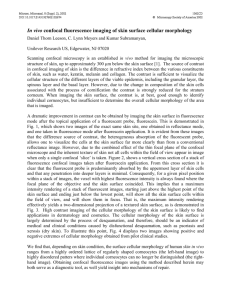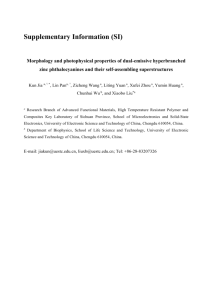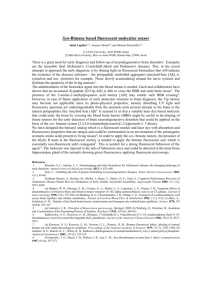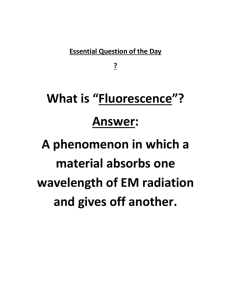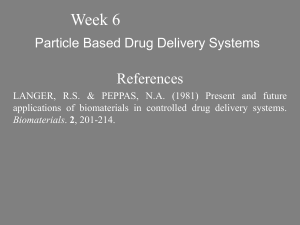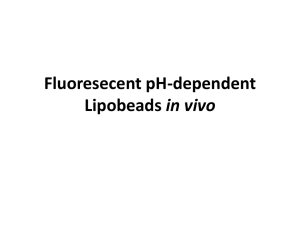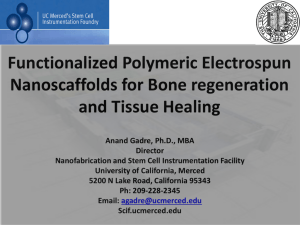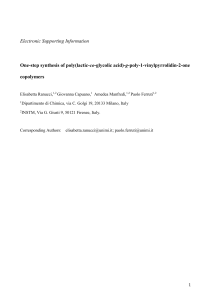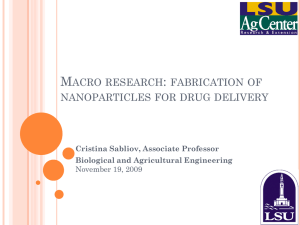Abstract - Te.Far.TI Modena
advertisement
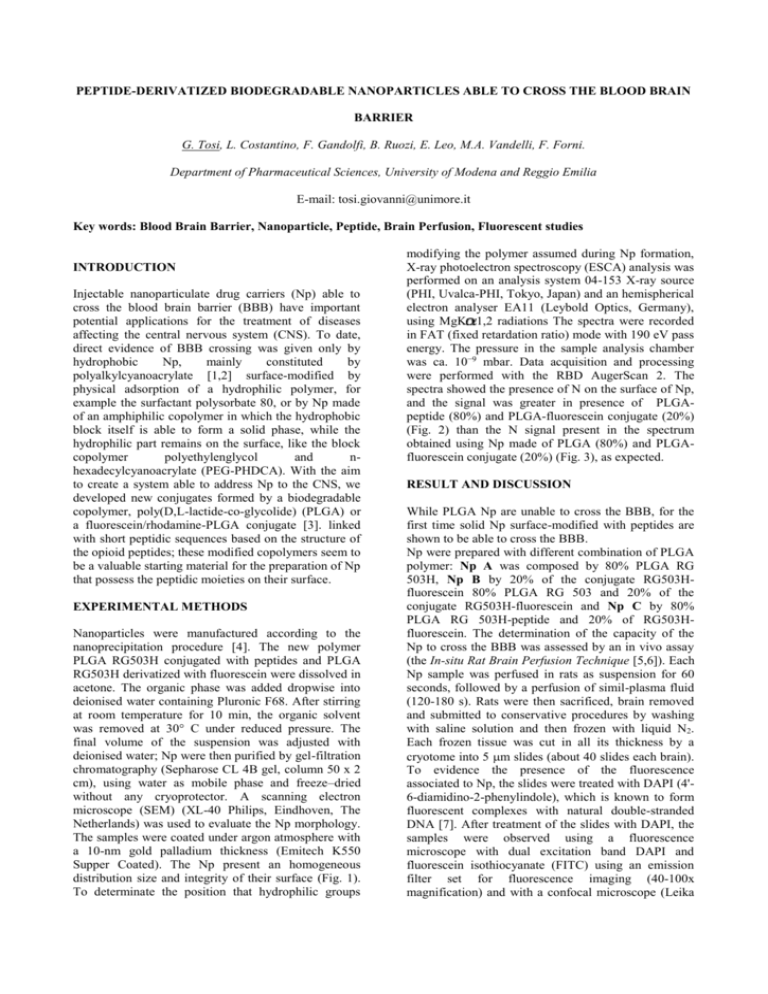
PEPTIDE-DERIVATIZED BIODEGRADABLE NANOPARTICLES ABLE TO CROSS THE BLOOD BRAIN BARRIER G. Tosi, L. Costantino, F. Gandolfi, B. Ruozi, E. Leo, M.A. Vandelli, F. Forni. Department of Pharmaceutical Sciences, University of Modena and Reggio Emilia E-mail: tosi.giovanni@unimore.it Key words: Blood Brain Barrier, Nanoparticle, Peptide, Brain Perfusion, Fluorescent studies INTRODUCTION Injectable nanoparticulate drug carriers (Np) able to cross the blood brain barrier (BBB) have important potential applications for the treatment of diseases affecting the central nervous system (CNS). To date, direct evidence of BBB crossing was given only by hydrophobic Np, mainly constituted by polyalkylcyanoacrylate [1,2] surface-modified by physical adsorption of a hydrophilic polymer, for example the surfactant polysorbate 80, or by Np made of an amphiphilic copolymer in which the hydrophobic block itself is able to form a solid phase, while the hydrophilic part remains on the surface, like the block copolymer polyethylenglycol and nhexadecylcyanoacrylate (PEG-PHDCA). With the aim to create a system able to address Np to the CNS, we developed new conjugates formed by a biodegradable copolymer, poly(D,L-lactide-co-glycolide) (PLGA) or a fluorescein/rhodamine-PLGA conjugate [3]. linked with short peptidic sequences based on the structure of the opioid peptides; these modified copolymers seem to be a valuable starting material for the preparation of Np that possess the peptidic moieties on their surface. EXPERIMENTAL METHODS Nanoparticles were manufactured according to the nanoprecipitation procedure [4]. The new polymer PLGA RG503H conjugated with peptides and PLGA RG503H derivatized with fluorescein were dissolved in acetone. The organic phase was added dropwise into deionised water containing Pluronic F68. After stirring at room temperature for 10 min, the organic solvent was removed at 30° C under reduced pressure. The final volume of the suspension was adjusted with deionised water; Np were then purified by gel-filtration chromatography (Sepharose CL 4B gel, column 50 x 2 cm), using water as mobile phase and freeze–dried without any cryoprotector. A scanning electron microscope (SEM) (XL-40 Philips, Eindhoven, The Netherlands) was used to evaluate the Np morphology. The samples were coated under argon atmosphere with a 10-nm gold palladium thickness (Emitech K550 Supper Coated). The Np present an homogeneous distribution size and integrity of their surface (Fig. 1). To determinate the position that hydrophilic groups modifying the polymer assumed during Np formation, X-ray photoelectron spectroscopy (ESCA) analysis was performed on an analysis system 04-153 X-ray source (PHI, Uvalca-PHI, Tokyo, Japan) and an hemispherical electron analyser EA11 (Leybold Optics, Germany), using MgK 1,2 radiations The spectra were recorded in FAT (fixed retardation ratio) mode with 190 eV pass energy. The pressure in the sample analysis chamber was ca. 10−9 mbar. Data acquisition and processing were performed with the RBD AugerScan 2. The spectra showed the presence of N on the surface of Np, and the signal was greater in presence of PLGApeptide (80%) and PLGA-fluorescein conjugate (20%) (Fig. 2) than the N signal present in the spectrum obtained using Np made of PLGA (80%) and PLGAfluorescein conjugate (20%) (Fig. 3), as expected. RESULT AND DISCUSSION While PLGA Np are unable to cross the BBB, for the first time solid Np surface-modified with peptides are shown to be able to cross the BBB. Np were prepared with different combination of PLGA polymer: Np A was composed by 80% PLGA RG 503H, Np B by 20% of the conjugate RG503Hfluorescein 80% PLGA RG 503 and 20% of the conjugate RG503H-fluorescein and Np C by 80% PLGA RG 503H-peptide and 20% of RG503Hfluorescein. The determination of the capacity of the Np to cross the BBB was assessed by an in vivo assay (the In-situ Rat Brain Perfusion Technique [5,6]). Each Np sample was perfused in rats as suspension for 60 seconds, followed by a perfusion of simil-plasma fluid (120-180 s). Rats were then sacrificed, brain removed and submitted to conservative procedures by washing with saline solution and then frozen with liquid N2. Each frozen tissue was cut in all its thickness by a cryotome into 5 m slides (about 40 slides each brain). To evidence the presence of the fluorescence associated to Np, the slides were treated with DAPI (4'6-diamidino-2-phenylindole), which is known to form fluorescent complexes with natural double-stranded DNA [7]. After treatment of the slides with DAPI, the samples were observed using a fluorescence microscope with dual excitation band DAPI and fluorescein isothiocyanate (FITC) using an emission filter set for fluorescence imaging (40-100x magnification) and with a confocal microscope (Leika DM IRE 2). Fluorescein and tetramethylrhodamine conjugates, giving green and red fluorescent spots, respectively, were considered the visible markers of nanoparticles (Fig. 4). Then, in order to allow a more precise location of the Np inside the nervous parenchyma, several studies on confocal microscopy have been performed. These details cannot be achieved from fluorescent microscopy studies, which give informations only in a bidimensional (2D) modality. The confocal images, owing to the 3D possibility of investigation, demonstrate the positions of Np (green fluorescence due to fluorescein) relating to the nucleus (blue fluorescence due to DAPI) of nervous cells. The Np (Fig. 6) are in a close contact with nuclear structures; in some cases, they are at the same level of nucleus, and in other cases they are located into the cytoplasm. Thus, in order to check the capacity of the Np composed of the copolymer PLGA RG503H derivatized with peptide (80%) and labelled with 20% PLGA-tetramethylrhodamine to avoid opsonization, these were injected into the femoral vein and after 60 min the presence of Np in the CNS was assessed. The image (Fig. 5) allow to recognize red spots, due to tetramethylrhodamine, that evidence the presence of Np in brain parenchyma. Even if some of the particles were found in the liver, it is very important to underline that some Np were found into the CNS parenchima. This represents a further confirmation of the important role of the modification of the Np with the peptidic sequences here considered in their ability to cross the BBB and confirm also the results previously obtained with brain perfusion experiments. 7. Z. Xu, D.S. Pilch, A.R. Srinivasan, W.K. Olson, N.E. Geacintov, K.J. Breslauer, Bioorg. Med. Chem. 5, 1137 (1997) Figure 1. Np SEM image Figure 2-3. ESCA studies on un-modified Np (2) and modified Np (3). Figure 4-5. Fluorescence studies on cerebral parenchyma, Np localization consequence to a crossing of BBB (fig. 4). Rhodamine derivatized Np: fluorescent microscopy image in cerebral tissue (fig.5) CONCLUSION A new polymeric conjugate was obtained with the aim of cerebral targeting; the methods used for the detection of Np aggregates, confocal and fluorescent microscopy, suit perfectly to our proposal, confirming that the new peptides here described can represent a useful way to target CNS by Np. ACKNOLEDGMENT Authors wish to thank Dott. A. Tombesi and Dott. C. Restani (CIGS, Univ. Modena and R.E.) for their technical support of confocal microscopical analysis. REFERENCES 1. 2. 3. 4. 5. 6. P.R. Lockman, R.J. Mumper, M.A. Khan, D.D. Allen, D.D. Drug Dev. Ind. Pharm. 28, 1 (2002). J. Kreuter, Adv. Drug Del. Rev. 47, 65 (2001). G. Tosi, F. Rivasi, F. Gandolfi, L. Costantino, M.A. Vandelli, F. Forni, Biomaterials 26, 4189 (2005) H. Fessi, F. Puisieux, J.P. Devissaguet, N. Ammoury, S. Benita, Int. J. Pharm. 55, R1 (1989). Y. Takasato, S.I. Rapaport, Q.R. Smith, Am. J. Physiol. 247, H484 (1984). P.R. Lockman, R.J. Mumper, D.D. Allen, J. Neurochem. 86, 627 (2003). Fig.4 Cerebral Parenchyma Fig.5 Figure 6. Confocal study performed in a single plane in z thickness on cerebral parenchyma Images are referred to the intensity per cent of green and blue coloration (respectively from fluorescent Np and DAPI-double strand DNA complexes) The spots included into the yellow ellipsis in figure 3C and 3D are considered as the points of interaction between fluorescent Np and cells.
